They say that a journey of a thousand miles begins with a single step. It’s such a pensive statement, full of zen-like logic and rife with possibility. You can’t help but nod your head in agreement at such obviously simple wisdom.
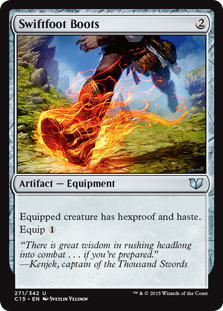
These could help speed up the process…
What they don’t tell you is that by the final mile you’re probably battered, mentally and physically exhausted, and even if your journey was successful, hard lessons were learned. Regardless of the intent or how positive the outcome, it’s almost impossible for such a journey to not exact some kind of toll.
That’s the state I find myself in as we near the end of this particular expedition. It was not an easy task, and I’m still second-guessing myself on the final dozen or so cuts, but we have reached the final step of our EDH journey.
Yes, Alesha deck is done.
As I’ve laid out numerous times on this series, taking the long-haul approach has some serious downsides. It takes substantially longer to accomplish than throwing it together in a day and requires dedicated commitment to an arduous cause. There are roadblocks and hurdles to overcome, including a near-constant threat of analysis paralysis to shut down your progress. And it leaves plenty of space for you to simply give up or walk away.
Yet if you stay on your path, keeping your feet moving forward one step at a time, you will reach your destination in the end. Yes, taking the long way round isn’t ideal if you’re lacking in time or patience, but I’ve continually been impressed with decks that take the effort to be slowly distilled. The same is true here today.
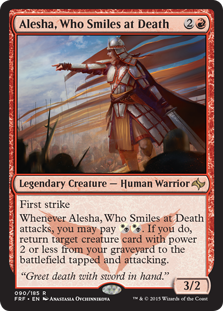
Time to unleash her fury!
I don’t think this deck is perfect – no deck truly is. I can already find theoretical flaws in it to address later, and I’d know how I’d slow its engine down if I were on the other side of the table, but no matter how much you tweak a deck, there will always be gaps in one form or another. So don’t get too fixated on stopping every potential problem area. Make it too situation-based and it’ll lose focus. Make it too finely-focused and it’s easy to shut down when someone figures out the linchpin.
Nevertheless, I’m quite happy with the the way the deck evolved over time, even if several facets of it have proven quite different than what my initial vision Alesha looked like. I’m fine with that though. In fact, watching the deck solidify and change the longer you hammer away at it is one of my favorite aspects to this style of building a deck. It makes for a more refined experience and exemplifies the meritorious side of a more drawn out methodology.
That said, I’m pretty sure we’ve all waited long enough. So let’s check out the final reveal.
Part Eight: The Final Cuts
When we last checked in with Alesha, Who Smiles At Death, we were staring down the barrel of possibilities. While it was light-years away from where we started those many weeks ago, it was these final few dozen which proved the most difficult to cull. This is natural and to be expected. It’s one thing to shave away large chunks when you’re whittling a sculpture down, but once you start fine-tuning the details, the work slows substantially. Cuts start being made with surgical precision, and that takes copious time and concentration. And as we discussed previously, it’s doubly so if you’re prone to indecision. This is what we had to work with going into the final bout:
Alesha's Final Auditions
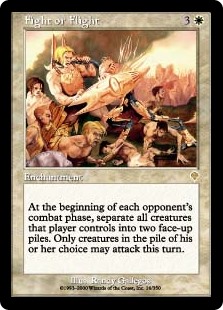
I had this internal conflict regularly
Sticking with the compartmentalizing approach with this deck definitely helped me, as Alesha is an incredibly malleable general and can take many forms. By working in specific categories, it allowed me to focus on certain aspects without getting overwhelmed or lost.
That said, to make some of the tough calls, I relied upon one of my more standby deck building decision-making processes: the This Or That game. This is where you take two cards that are similar in some way (purpose, cost, color, etc.) and pit them against each other. Two Cards Enter, One Card Leaves. I find it works well, as it forces me to fine-tune the cards I truly want and provide justification for them, be it on a mechanical or flavor level. Because of Alesha’s versatility, there was a lot of that with this deck in the end.
To showcase this, I figured it’d be helpful to stick with the some of the same category groupings as last time to see how I arrived at my final decisions.
Unable to Be Alesha-fied
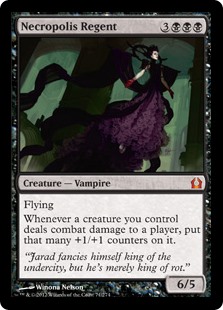
One of the only mid-build additions to make the final deck. This happens.
Call it parity or the desire for responses, but I ultimately decided on having the deck be exactly 1/3 creatures. Too many with small power and I feared running into being ineffective. Too few and I’d worry about the deck not doing what I want it to, which is use Alesha as often as I can. 33 seemed like a good goal number and helped me have something to work towards. Not only did this mean that 23 creatures overall had to go, but since it was lower than my initial plan of about 35, I wanted to drop the non-Alesha creature count by another one. I originally was aiming for six; now five was the magic number. These were the final eight:
Adakar Valkyrie Brutal Hordechief Flayer of the Hatebound Iroas, God of Victory Mikaeus, the Unhallowed Necropolis Regent Ogre Battledriver ReveillarkOff the bat I knew that Iroas, Reveillark and the Battledriver were on my necessary-to-keep list, so those were safe. The Hordechief was the first to go, as I really only wanted him for the combat manipulation, and since that was something that kept getting stripped out in other places (i.e. Master Warcraft), he felt the weakest of the bunch. The Flayer was next. I compared him to Warstorm Surge, and since they both cost the same but the Surge helps even if I cast creatures (scandalous!), it won out. I’d love to have both, but alas.
That left one final slot. The latecomer Necropolis Regent kept making a better and better case for its inclusion, so one of the other two other needed to go. It came down to Adakar versus Mikaeus, which is painfully sad. Still, there’s a decent amount of recursion in the deck as it is; I could afford to lose one. In the end Mikaeus won out. His being able to buff everyone, keep most of my army alive and be a decent attacker all helped, although ironically the one thing he can’t do is keep Alesha herself around. Still, saving almost the entire board seemed more worth it compared to saving just one.
Auras & Equipment
As I expected, this area was going to get heavily truncated in the end. It was unfortunate, but it made sense with the build I was going with.
Angelic Destiny Deathrender Gift of Immortality Infiltration Lens Obsidian Battle-Axe Sunforger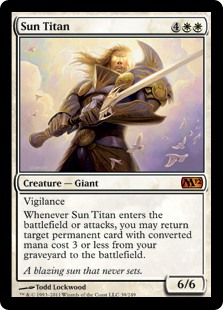
Still managed to channel the sun after all
Gift of Immortality was a lock, as it on any creature will be helpful – doubly so on my Commander. Everything else here felt fair game for the axe though. Sunforger was kept because on paper it looks useful. 13 of the 20 Instants on the preliminary list (later 8 of the final 11) could be tutored for and the +4/+0 fits really well with the first/double strike angle I was hoping for. The Axe was cut because in the end it only really worked with Alesha, and I keeping an equipment with auto-equip haste for 1-3 creatures seemed silly. Then, because I wanted to limit their inclusion further, they faced off. Deathrender lost out to Angelic Destiny for being able to bring itself back, but then ended up losing to Infiltration Lens anyhow because I felt that paying 4 mana constantly for an (albeit exceptional) buff in this deck seemed a waste compared to a single mana and the possibility of drawing cards easily.
Reanimation
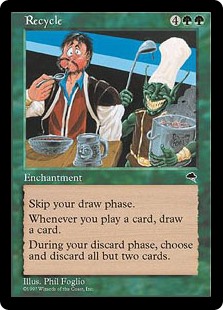
Creature churn churn churn
Lots of reanimation here, and yet it was curtailed a bit in the end. Our options included:
Adakar Valkyrie Faith’s Reward Gift of Immortality Grimoire of the Dead Karmic Guide Liliana, Heretical Healer Mikaeus, the Unhallowed Obzedat’s Aid Reveillark Sorin, Lord of Innistrad Unburial RitesOf these, the Adakar had already been cut, and Mikey, Reveillark, and Gift of Immortality were already in. Karmic Guide and Liliana also work way too well to not have a presence. I was also adamant to include Sorin for his lifelink creatures and buffing emblem, but his ultimate could also be useful. Unburial then lost to Obzedat’s Aid. I love the flashback of the Rites but in the end opted for being able to return noncreatures over a second iteration. Faith’s Reward lost to Boros Charm as they had the same premise of protecting my army, and unfortunately the Grimoire lost out to a combination of Trading Post and Liliana. Some day I will get that artifact in a deck. But not this day.
Removals
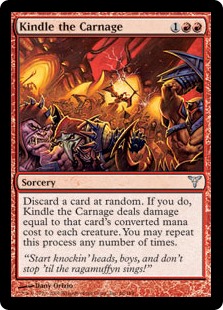
That’s the idea. My Alesha loves carnage, apparently.
There was a lot of board wipes and spot removals in the list to work with, which was cool. However, it also meant things had to go. From the board wipe side we had quite a few options:
Arcbond Austere Command Coercive Portal Elspeth, Sun’s Champion False Prophet Magmasaur Magus of the Tabernacle Retribution of the Meek Tragic ArroganceMagmasaur and False Prophet were removed because they were likely to hurt me as much as help me, since few of my creatures could ever survive the dinosaur and I’d rather not have my dead creatures exiled in this deck. Elspeth then lost to Retribution of the Meek. I mostly wanted Elspeth for her second ability anyhow and opted for the cheaper, safer option. Tragic Arrogance next beat Austere Command since the deck focuses on power rather CMC. I liked Arcbond for flavor and a surprise gutshot for when things go inevitably south on me. Lastly was the Magus. The Magus was one of the final cuts and may yet find its way back in. It’s an anti-token card, which I like having, but I opted to remove it so Knight-Captain of Eos had a spot instead. I figured Fog on a stick was better than making everyone hate me…more.
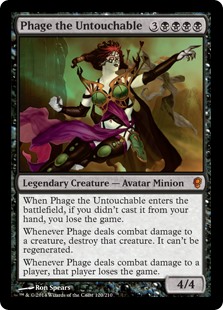
And you die, and you die, and you die…
Spot removal was equally robust:
Agonizing Demise Crackling Doom Dark Imposter Darksteel Mutation (technically an Aura but I lumped it in with removal)Duergar Hedge-Mage Duplicant Hide Martyr’s Bond Mortify Necrotic Sliver Orim’s Thunder Utter End
Funny enough, most of these made it in. The Hedge-Mage, Duplicant, and Sliver all work well with Alesha, and Crackling Doom is just efficient evil fun. Still, Utter End lost to Mortify for cost reasons and the Imposter lost to Duplicant. Finally, it’s notable that Hide/Seek lost to Orim’s Thunder because the deck had been evolving a “punisher” effect over time and I wanted to foster that. It’s the same reason Agonizing Demise made the cut, as did Deflecting Palm, Reflect Damage, and Comeuppance. The Mutation, not so much. I really wanted to keep Martyr’s Bond too, but it didn’t make it simply because of space reasons. At least for now. It may return.
Either way, you will pay for your indiscretions whether I attack or not.
Draws, Tutors, & Fetches
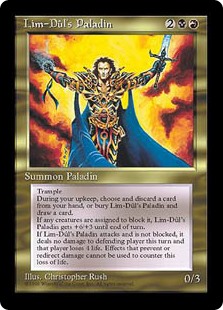
I told you’d he make it
These are some of your standard areas you see in deck construction, and I’d be remiss if I ignored them completely. So here goes. For draw I ended up with:
Coercive Portal Infiltration Lens Lim-Dul’s Paladin Mentor of the Meek Phyrexian Arena Toil/TroubleMost of these made it in, though the Arena was a tough cut against the Portal, mostly because I worry getting double Black early may be tricky. Plus the politics of the Portal is fun. Toil also didn’t make it, but mostly because of space reasons.
On the turor side the finalists included:
Demonic Collusion Insidious Dreams Netherborn Phalanx Sunforger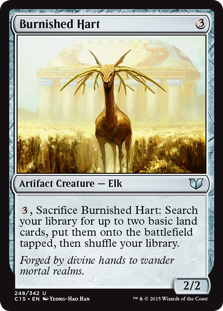
This poor beast is going to be all sorts of fodder
Sunforger was already in, and when all was done Demonic Collusion’s buyback effect beat Dream’s ability to stack the graveyard. The Phalanx may have ended up with only a handful of tutor options in the final deck, but it made it in too. Though in reality it’s in there more for its ETB effect. The transmuting is more a bonus.
As for fetches, (more of which will come into play shortly), we had just three:
Burnished Hart Gleam of Resistance Solemn SimulacrumBoth creatures were guaranteed slots. Because I had long since moved away from a ‘basic land matters’ subtheme, however, I made a last minute substitution. Gleam of Resistance was swapped with Expedition Map…and then included in the mix.
Miscellaney
There were a dozen other categories cards were considered under, but rather than go through each and every one, here are just a few more examples of my tit-for-tat card choices:
- Savage Beating beat Waves of Aggression. The entwine effect was too scary to pass up.
- Silverblade Paladin beat Markov Blademaster purely on tempo matters.
- Sewer Nemesis beat Guiltfeeder for utility purposes, as the Nemesis could potentially help me feed my graveyard.
- Ignition Team edged out Entropic Specter which had edged out Savage Firecat. This is strictly a personal choice as I think a large surprise vanilla creature could be more potent than a medium-sized flyer. I could reverse course if it proves otherwise.
- Both Blind Obedience and Resilient Wanderer bested competition in forms of Citadel Siege and Pack Rat, respectively, only to both being cut after all. Obedience may come back one day though if I get stomped on repeatedly.
- Herald of Leshrac won out over Drana, Liberator of Malakir only by virtue of…I don’t actually have one yet. Whoops! My bad. In the meantime I’ll give the Herald a run. I like him on paper but I have a nagging feeling in this deck he may not work in the long run.
Part Eight And A Half: Mana Fixing And Final Thoughts
Addressing mana fixing in a deck has enough material for its own article, but it seems prudent to address it briefly here as well.
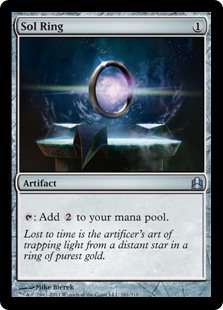
Whaaa?? No Sol Ring?!?
I should state right off the bat that I don’t adhere to what many would consider ideal statistics for mana fixing and ramping. Many players insist on having 40% or more of a mana base between lands and / or mana rocks such as Sol Ring, Manalith, etc. While I don’t disagree that having a reliable mana base and useful acceleration is useful – or down right necessary in many decks – it wasn’t the tact I took with Alesha here. As aforementioned, at the onset of beginning this deck I was going to try for a ‘basic land matters’ subtheme. Between that and the high degree of board wipes, I made the conscious decision early on to avoid using mana rocks if at all possible. Hence why you don’t see them in the deck list.
I do have at least three card that let me fetch lands, as well as a Praetor’s Grasp that I could use to steal accelerants from another deck as needed. I also decided Alesha should be relatively lean for an EDH deck, which actually panned out: half of the final deck costs three mana or less; another 23% is only CMC four. And that says nothing of the fact that many higher CMC creatures won’t be routinely cast as much as resurrected into combat. So I feel fairly confident that the deck doesn’t actually need a lot more acceleration than I currently have. This is all conjecture and could backfire on me, of course, so we’ll see. This is the one true area where actual gameplay testing will be helpful. For now, I’m going to stick with what I have listed and the standard 33% mana ratio.
That said, one way to offset using mostly basic lands outside of access to Green or mana rocks is the idea of mana thinning. This is stuff like Terramorphic Expanse, panoramas, or fetchlands. It’s more of a tourney-style tactic, using lands to fetch for other lands. It thins your deck by small percentages and increases your odds of drawing more useful cards. Although I had decided a while back (probably around Part V) that I wasn’t going to stick with the basic land subtheme anymore, I still set my mind on using the thinning method to see if it could work. Even still, tried to keep at least a third of the deck as basic land for basic land fetching.
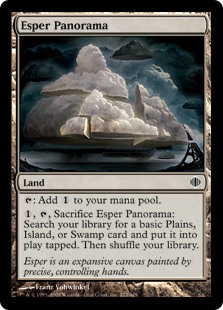
Almost as useful, a fraction of a fraction of the cost
The only caveat to this is that it likely means using fetchlands, which can be expensive to attain. Which is always a reminder that you shouldn’t ever feel like you have to go out and spend ridiculous amounts of money on lands for an EDH deck. It’s really not worth it. I happen to have a few fetchlands lying around, but if I didn’t, there are other fetch options that can also work, such as the Alara panoramas.
Now, as for nonbasics in general, opening up that opportunity of choice is liking handing a bag of candy to me. I have a thing for nonbasic lands. I always have. I’m one of those people that actually gets excited when a useful land gets opened in a pack. Luckily in Commander, there’s no shortage of use for them.
However, we must be careful. Since this is a tricolor deck, we want to keep the number of nonbasics that don’t tap for a color fairly low to avoid making mana balance issues even worse. Moreover, since the composition of the deck leans slightly more White than the other two colors, we want to ensure that we have a decent breakdown of lands to help with that.
As a side note, it’s interesting her being more White in nature, leading me to believe that this Alesha build is a little more utility-based or defensive than I imagine some builds could be. Indeed, my version certainly isn’t made to be a glass cannon. To that end, here it is, the alpha run of Alesha, Who Smiles Back:
Alesha's Final Auditions
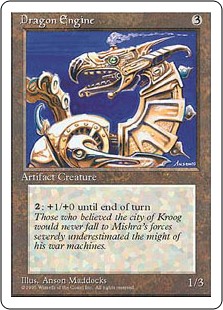
Engine Complete. Destroy at will.
I hope you found this deckbuilding series exercise both interesting and, ideally, a little informative. Taking the long approach to an EDH deck build isn’t the most common one, and given the time and effort requirements to make it work, it’s certainly not the sexiest method either. But for some folks like myself, it works if you stay dedicated, making it just as valid of an approach as any other. If you stick to the goals laid out and really drill down into the decision-making process, it can be a highly worthwhile experience, both as a way of understanding how you want the deck to work right from Day One, as well as illuminating some of your own gameplay preferences and styles.
So, now’s the time to take it for a test run and see how it does. This may be the completion of the deck creation journey, but it’s the first step in the journey of a brand new deck being brought into the world. Let’s see what happens! Till next time.
